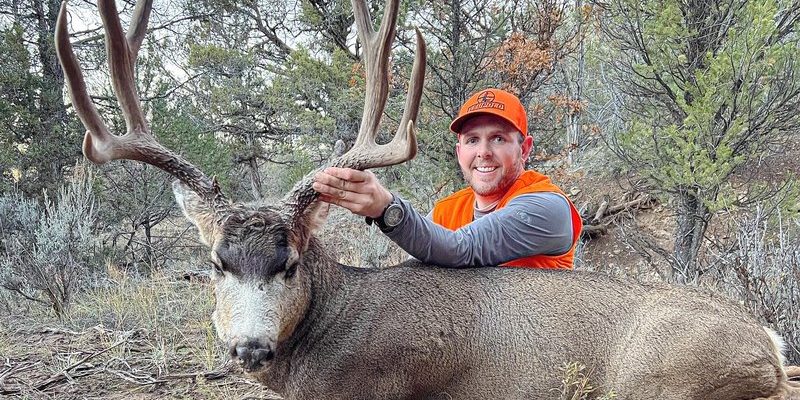
Imagine you’re sitting around a cozy campfire in the mountains, chatting about the beauty of nature. You start to wonder, what exactly do these deer munch on, and how do they manage to stay safe from predators? Let’s dive into their world and explore their eating habits and hunting (or rather, avoiding being hunted) strategies. By the end, you’ll have a clear picture of what makes these beautiful creatures tick.
What Do Mule Deer Eat?
Mule deer are herbivores, meaning their diet consists mainly of plant matter. They’re like picky eaters who know exactly what they like. Their typical meals include a variety of leaves, shrubs, and grasses. In the spring and summer, you’ll often find them munching on lush green plants and flowering herbs. This is when their diet is rich in protein, which is crucial for fawns’ growth and overall health.
In fall and winter, things get a bit trickier. The landscape changes, and mule deer adapt by switching to hardier fare. During these colder months, they eat twigs, bark, and evergreen needles. Imagine swapping your fresh salad for hearty soup in winter; that’s what mule deer do! They can also consume plants with high fiber content, thanks to their unique digestive systems that break down tough plant materials efficiently.
Mule deer are known for their ability to forage. They have a keen sense of smell and can spot food from quite a distance. This skill is essential, especially when food is scarce. By scanning their environment and using their sharp eyesight, they can find tasty treats hiding in plain sight.
Hunting Strategies of Mule Deer
Now, when we talk about hunting strategies, remember that mule deer are not predators. Instead, they need to stay one step ahead of those that are. Think of them as the ultimate masters of hide-and-seek. Their primary strategy is being stealthy. Mule deer often rely on their excellent hearing and vision to detect potential threats. They have large ears and can pivot them independently, allowing them to pick up sounds from all directions.
When danger approaches, what do you think they do? They freeze! This might remind you of that moment in a scary movie when someone tries to hide from a monster. Mule deer often stand still, blending in with their surroundings. Their brownish fur helps them camouflage in the woodland and grasslands, making it hard for predators to spot them.
If that doesn’t work, they have a clever backup plan. Mule deer are swift runners and can reach speeds of up to 30 miles per hour. When they do decide to flee, they make zig-zag patterns to throw off any pursuing predators. Imagine trying to catch a rabbit; it’s tricky because they dart around unexpectedly. Mule deer employ a similar tactic, making it harder for predators to keep up.
Seasonal Diet Changes
The diet of mule deer isn’t just about what they love to eat; it’s also about what’s available at different times of the year. As the seasons change, so does their menu. In spring, when everything is blooming, they feast on tender shoots and rich foliage. This is when they bulk up, preparing for the challenging months ahead.
Come summer, they enjoy a buffet of diverse vegetation. Grasses and herbs are plentiful, and these provide the energy needed for their activities. However, as fall rolls around, their diet shifts again. They start to consume acorns, berries, and other fruits, which can be found in abundance during this season.
Winter presents a unique challenge. With snow covering the ground, accessing food becomes a daily adventure. Mule deer may dig through the snow to find hidden grass or browse on shrubs and trees. This adaptability is critical for survival, showcasing how resourceful these creatures can be. They truly become experts in finding food, no matter the obstacles.
Common Predators of Mule Deer
Mule deer have several natural enemies, making their survival strategies all the more critical. Wolves, mountain lions, and coyotes are among their primary predators. Each of these hunters has its unique tactics, which means that mule deer need to stay alert.
Wolves tend to work as a team when hunting, using coordinated efforts to chase down prey. Mountain lions, on the other hand, are solitary ambushers that rely on stealth and surprise. You might imagine a lion crouching behind a bush, waiting for just the right moment to pounce.
Coyote packs use a variety of calls to communicate during hunts, making them incredibly effective at locating deer. This multi-pronged predator approach means that mule deer have to be extra vigilant. They often stay in open areas where they can see danger coming, allowing them to escape before it’s too late.
How Mule Deer Use Their Environment
The environment plays a significant role in how mule deer thrive. They are often found in mountainous regions, forests, and open plains, which provide both food and cover. These habitats offer the perfect balance between foraging opportunities and safe hiding spots.
Within their environment, mule deer also use their keen senses to their advantage. Their large ears catch subtle sounds that other animals might miss. They can detect the faint rustle of leaves or the crunch of twigs, alerting them to potential danger.
Furthermore, mule deer have a unique way of moving through their territory. They often follow the same trails along ridges or through forests, creating paths that become familiar to them. Just like you might know the quickest way to your favorite coffee shop, these deer know their routes well, allowing them to navigate efficiently while foraging.
Mule deer are a perfect blend of grace and cunning. Their diet and hunting strategies illustrate their adaptability and resilience in the wild. From expertly navigating their environment to employing clever tricks to evade predators, they showcase the beauty of nature’s design.
Understanding the diet and hunting strategies of mule deer not only enriches our appreciation of wildlife but also emphasizes the importance of preserving their habitats. As we marvel at these incredible creatures, it’s essential to remember that the balance of nature is delicate. Protecting their environment ensures that these majestic animals continue to thrive for generations to come.

